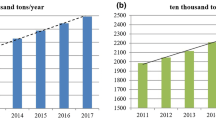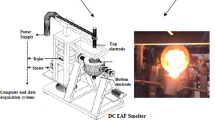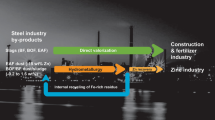Abstract
Copper concentrates are widely used in smelting operations worldwide and typically consist of chalcopyrite (CuFeS2) as the primary mineral, with chalcocite (Cu2S) and bornite (Cu5FeS4) as secondary copper-bearing minerals. However, these concentrates often contain hazardous impurities, such as the fluorine ion, which can result in various complications during the smelting process. These issues include equipment corrosion, gas treatment requirements, environmental hazards, and strained community relations. Furthermore, high fluorine content in copper concentrates can lead to penalties and limitations during sales. To address these challenges, this comprehensive review assesses current techniques for removing fluorine from copper concentrate. Drawing upon recent research and the findings in the field, the review analyzes the advantages and disadvantages of existing fluorine removal methods and identifies critical issues requiring attention in the future. This review provides valuable insights into the current state of fluorine removal from copper concentrates and serves as a practical guide for researchers and industry professionals in this field.








Similar content being viewed by others
Change history
12 August 2023
A Correction to this paper has been published: https://doi.org/10.1007/s42461-023-00831-0
References
Yang Z, Yang Z, Yang S, Liu Z, Liu Z, Liu Y et al (2022) Life cycle assessment and cost analysis for copper hydrometallurgy industry in China. J Environ Manag 309:114689
Marsden JO (2008) Energy efficiency and copper hydrometallurgy. Hydrometallurgy:29–42
Yang Y (2010) Treatment of high fluorine copper concentrates. China Nonferrous Metallurgy 2010(5):32–34
Shen F, Chen X, Gao P, Chen G (2003) Electrochemical removal of fluoride ions from industrial wastewater. Chem Eng Sci 58(3-6):987–993
Arena FA, Suegama PH, Bevilaqua D, Dos Santos AL, Fugivara CS, Benedetti AV (2016) Simulating the main stages of chalcopyrite leaching and bioleaching in ferrous ions solution: an electrochemical impedance study with a modified carbon paste electrode. Miner Eng 92:229–241
Ragozzini RJ, Ross-Smith MA, Sparrow GJ, Walker GS (1986) Selective dissolution of uranium from a copper flotation concentrate. Hydrometallurgy 16(3):377–393
Santos AL, Arena F, Benedetti A, Bevilaqua D (2017) Effect of redox potential on chalcopyrite dissolution imposed by addition of ferrous ions. Eclética Quím 42
Watling HR (2006) The bioleaching of sulphide minerals with emphasis on copper sulphides—a review. Hydrometallurgy 84(1-2):81–108
Pradhan N, Nathsarma KC, Rao KS, Sukla LB, Mishra BK (2008) Heap bioleaching of chalcopyrite: a review. Miner Eng 21(5):355–365
Schlesinger ME, Sole KC, Davenport WG, Alvear GR (2021) Extractive Metallurgy of Copper. Elsevier
Torrisi C (2001) Leaching of fluorine bearing minerals from lead and zinc concentrates. Miner Eng 14(12):1637–1648
Lane DJ, Cook NJ, Grano SR, Ehrig K (2016) Selective leaching of penalty elements from copper concentrates: a review. Miner Eng 98:110–121
Pangum LS, Glatthaar JW, Manlapig EV (2001) Process mineralogy of fluorosilicate minerals in ok tedi ores. Miner Eng 14(12):1619–1628
Fountain C (2013) The whys and wherefores of penalty elements in copper concentrates. In: MetPlant 2013. Australasian Institute of Mining and Metallurgy, pp 502–518
General Administration of Quality Supervision, Inspection and Quarantine of the People's Republic of China, Standardization Administration of the People's Republic of China (2006) GB 20664—2006 Limitation concentration of natural radioactivity in non-ferrous metal mineral ores and concentrates products. Institute for Standardization of Nuclear Industry, Beijing
Salomon-de-Friedberg H, Robinson T (2015) Tackling impurities in copper concentrates. ALTA 2015:398–408
Noakes M, Lanz T (1993) Cost estimation handbook for the Australian mining industry, p 338
Wells, W. (2022). China's top copper smelters hike Q4 treatment charge floor price to 4-year high on ample supply. S&P Global Platts. https://www.spglobal.com/commodityinsights/en/market-insights/latest-news/metals/092722-chinas-top-copper-smelters-hike-q4-treatment-charge-floor-price-to-4-year-high-on-ample-supply Accessed 8 April 2023
London Metal Exchange, http://www.lme.com/metals/non-ferrous/copper/. Accessed 8 Apr 2023
Petruk W (2000) Applied mineralogy in the mining industry. Elsevier, p 268
Butcher A (2010) A practical guide to some aspects of mineralogy that affect flotation. In: Greet CJ (ed) Flotation Plant Optimisation; a Metallurgical Guide to Identifying and Solving Problems in Flotation Plants. AusIMM, The Minerals Institute, pp 83–93
Pangum, L. S., Manlapig, E. V., Mackinnon, I. D. R., & Lauder, D. W. (1997, October). Flotation process response of Ok Tedi fluorine bearing minerals. In PNG Geology, Exploration and Mining Conference, Madang, Papua New Guinea, 1997, Proceedings: Melbourne, Australasian Institute of Mining and Metallurgy (pp. 173-180).
Pangum LS (1999) Process mineralogical response of fluorine-bearing minerals in Ok Tedi Ores (PhD Thesis). The University of Queensland, Australia
Barns, K. E., Colbert, P. J., & Munro, P. D. (2009, October). Designing the optimal flotation circuit–the Prominent Hill case. In Proc. Tenth Mill Operators Conference, Adelaide (pp. 173-182).
Cheng S, Sun Z, Xu Q, Huang G, Shi L (2022) Flotation process for reducing fluorine content in copper sulfide concentrate. CN:114798186A
Andrade VL, Santos NA, Nardi RP (1999) Technological development for Igarape Bahia/Alemao copper-gold project. In: Hancock BA, Pon MRL (eds) Copper-99-Cobre99, Mineral Processing, Environment, Health and Safety, vol II. The Minerals, Metals and Materials Society, Warrendale, pp 113–127
Li H, Wang C, Hu Z, Li P (2016) Reducing the content of fluorine and magnesium in a copper sulfide concentrate in Anhui Province using the inhibitor DG11. Metal Mine 7(481):121–124
Atluri V, Jin J, Shrimali K, Dang L, Wang X, Miller JD (2019) The hydrophobic surface state of talc as influenced by aluminum substitution in the tetrahedral layer. J Colloid Interface Sci 536:737–748
Atluri V, Gao Y, Wang X, Pan L, Miller JD (2019) The influence of polysaccharides on film stability and bubble attachment at the talc surface. Min Metall Explor 36:71–80
Yang D (2020) Research and practice of improving copper concentrate quality by reverse flotation. World Nonferrous Metals 05:54–55
Agorhom EA, Lem JP, Skinner W, Zanin M (2015) Challenges and opportunities in the recovery/rejection of trace elements in copper flotation-a review. Miner Eng 78:45–57
Jomoto K, Hughes TC (1998) U.S. Patent No. 5,830,424. U.S. Patent and Trademark Office, Washington, DC
Reeve JS (1990) Olympic Dam copper-uranium-gold-silver deposit. Geology of the mineral deposits of Australia and Papua New Guinea, pp 1009–1035
Viana A, Andrade PM, Duarte Neto J, Pereira GSP, Torres VM (1998) New process to remove fluorine from copper concentrates. Min Eng 50(9):61–64
Silva R, Couto D, Tavares A, Guimarães L (2021) Enhanced process route to remove fluorine and uranium from copper concentrades by selective sulfuric acid leaching. Miner Eng 170:107039
Temuujin J, Okada K, Jadambaa T, Mackenzie KJD, Amarsanaa J (2002) Effect of grinding on the preparation of porous material from talc by selective leaching. J Mater Sci Lett 21(20):1607–1609
Okada K, Arimitsu N, Kameshima Y, Nakajima A, MacKenzie KJ (2005) Preparation of porous silica from chlorite by selective acid leaching. Appl Clay Sci 30(2):116–124
Okada K, Miyano T, Miyake M (2003) Activation of pig oocytes by intracytoplasmic injection of strontium and barium. Zygote 11(2):159–165
Freeport-McMoRan Inc. (2022). Technical report summary of mineral reserves and mineral resources for Grasberg Minerals District, Central Papua, Indonesia. https://www.fcx.com/sites/fcx/files/documents/operations/TRS-ptfi.pdf. Accessed 8 Apr 2023
Funding
This research received financial support from the Central South University Startup Fund and the National Key Research and Development Program of China (No. 2022YFC2905104).
Author information
Authors and Affiliations
Corresponding author
Ethics declarations
Competing Interests
The authors declare no competing interests.
Additional information
Publisher’s Note
Springer Nature remains neutral with regard to jurisdictional claims in published maps and institutional affiliations.
Rights and permissions
Springer Nature or its licensor (e.g. a society or other partner) holds exclusive rights to this article under a publishing agreement with the author(s) or other rightsholder(s); author self-archiving of the accepted manuscript version of this article is solely governed by the terms of such publishing agreement and applicable law.
About this article
Cite this article
Liu, W., Zhao, Y., Chen, J. et al. Advancements in Removing Fluorine from Copper Concentrate. Mining, Metallurgy & Exploration 40, 1487–1497 (2023). https://doi.org/10.1007/s42461-023-00820-3
Received:
Accepted:
Published:
Issue Date:
DOI: https://doi.org/10.1007/s42461-023-00820-3




